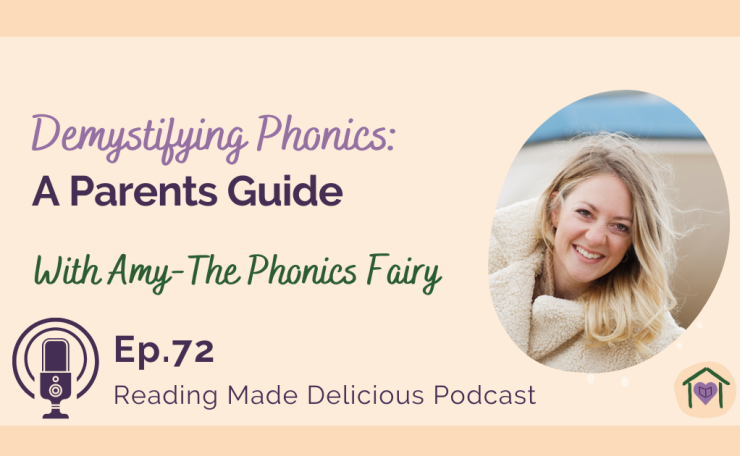Understanding Phonics for your child’s reading
Listen on your chosen podcast player
Many parents find themselves mystified by the term “phonics.” It’s a crucial skill for children learning to read, yet if you’re not involved in the education sector, you might not know much about it. Starting school with no understanding of phonics can be overwhelming for both parents and their children.
This episode with guest Amy, also known as the Phonics Fairy, helps to break down what phonics is and how you can help your child grow in reading.
In this episode about phonics:
Understanding the Basics
Phonics is essentially the relationship between the letters on a page and the sounds those letters represent. At its simplest, phonics begins with teaching single letter sounds, such as B and D. From there, children move on to blending these sounds to form words. For instance, knowing ‘d’, ‘o’, ‘g’ and blending them back together to read ‘dog’.
The Phases of Learning to Read
Early Stages
The journey of learning to read starts with understanding single letter sounds and then blending these sounds to form simple words, known as CVC (consonant-vowel-consonant) words. For example, blending ‘m-u-d’ to form ‘mud’.
Advanced Blending
As your child progresses, they encounter digraphs, where two letters make one sound, like ‘ch’ in ‘chin’ or ‘sh’ in ‘ship’. This is followed by more complex words that may have four or five sounds.
Vowel Digraphs and Speed
Vowel digraphs, such as ‘ay’ in ‘play’ or ‘ai’ in ‘snail,’ come next. By the end of Year One, children should be able to decode these combinations. From Year Two onwards, the focus shifts to reading fluency, where understanding and enjoying texts become priorities.
Preparation Before School
Preparation for phonics and reading begins long before school starts. Reading stories to your child from a very young age immerses them in the rhythm and structure of language they won’t hear in everyday conversations. Nursery rhymes, poems, and consistent, talkative interactions are crucial.
Engaging Preschool Activities
For preschoolers, focus on oral blending through games like “I spy” with sounds. This helps them understand that words are made up of individual sounds (phonological awareness), building a strong foundation before they see and learn letters.
Supporting School-Age Children
Once your child starts school, collaboration with their teacher becomes vital. Knowing the phonics program and the sounds they are learning can help you practice at home. It’s about repetition and making phonics a fun, everyday part of life rather than a chore.
The Importance of Practice and Routine
Introducing reading books should be approached gradually. Some children may not bring home a reading book until they can confidently blend sounds they’ve learned in school. Balancing reading practice between school and home is key without making it overwhelming.
Tips for Busy Parents
Incorporating reading and phonics practice into daily routines can make a big difference. Morning reading sessions, quick car ride sessions, or short evening practices can keep it enjoyable and stress-free.
Above all, consistency in reading to your child, even from infancy, lays the groundwork for their reading journey. High-quality picture books and stories enhance their language skills and comprehension. Remember, the ultimate goal is to foster a love for reading and understanding, and that’s something that starts with you.
More about Amy
I’m Amy, otherwise known as the Phonics Fairy. I have been a phonics consultant for over 10 years and have worked in some of the most socially deprived areas in the UK helping schools to teach children to learn to read. Just over a year ago, I spotted a gap; parents don’t often know how their kids are being taught to read. My mission is simple… to de-mystify phonics for parents.
Links mentioned in this episode about phonics:
Phonics Fairy Instagram:@phonicsfairy
Reading Made Delicious Resources to help support you
- Download the ultimate guide to using recipes for learning to read and get started with helping your child create memories whilst learning to read today.
- Check out the latest Reading Made Delicious recipes and reading support here
Join our Reading Made Delicious Podcast Community to grow your child’s reading and early learning:
Send me a DM on Instagram. I love chatting with families (and other educators). So send me your thoughts on phonics.
Enjoying the podcast? Thanks for tuning in!
Tag me @reading_made_delicious on Instagram and tell me what you are listening to! I love seeing what resonates most with our listeners!
I don’t want you to miss a thing! Be the first to know when an episode is available by subscribing to your favourite player here Apple Podcasts – Spotify – Amazon Music – Google Podcasts
If you would like to support the Reading Made Delicious Podcast, it would mean so much to me if you would leave a review on iTunes. By leaving a review, you are helping more families to find this and help support their child’s learning journey.
To leave a review on iTunes, click here and scroll down to ratings and reviews. Click ‘write a review’ and share with me how this podcast is helping you grow your child’s learning.
Ready for more? Listen to these Reading Made Delicious Podcast Episodes next:
- Phonics 101: The Quickstart guide (Ep.7)
- How can I help with knowing when my child should take a breath [Ep 62]
Content Disclaimer
The information contained above is provided for information purposes only. The contents of this episode are not intended to amount to advice and you should not rely on any of the contents of this podcast. Professional advice should be obtained before taking or refraining from taking any action as a result of the contents of this podcast. Sarah Travers disclaims all liability and responsibility arising from any reliance placed on any of the contents of this episode.


[…] Demystifying Phonics: A Parent’s Guide with the Phonics Fairy [Ep 72] […]